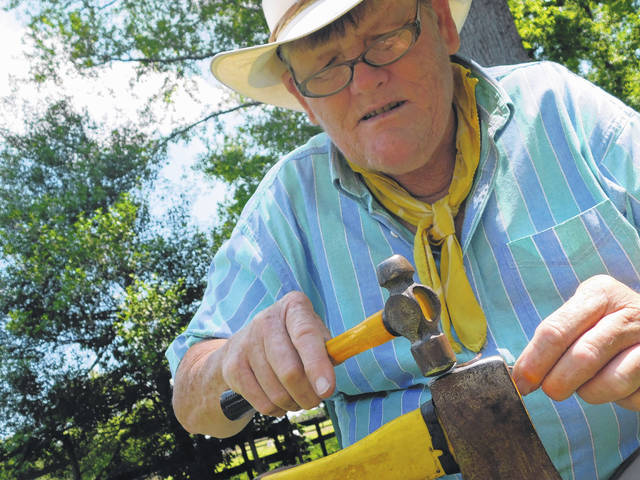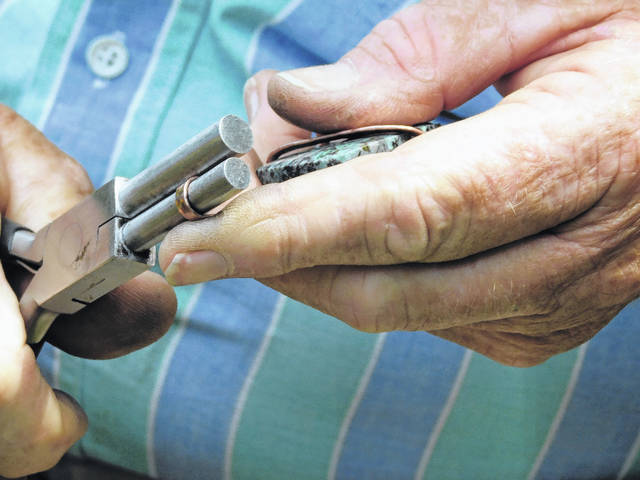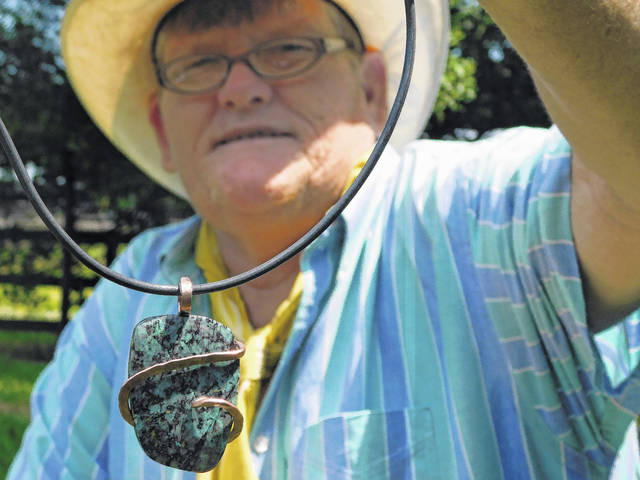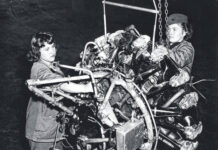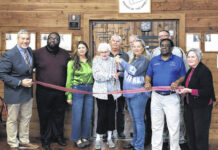ORRUM — Living just on the outskirts of Orrum at a property home to a horse stable, barn and lots of chickens sits “Cowboy” Bill Davidson performing the technique of cold forge wire wrapping, also known humorously as hillbilly wire twisting.
Living what Davidson calls the “bachelor lifestyle” allows him to cover almost every surface of his home with anything involving precious stones and/or wire wrapping.
“Where is my shop? Everywhere,” Davidson said.
The 61-year-old is a dual resident of Orrum and Quartzite, Arizona, which is known as the “boondocking” capital of the world and as a mecca for visitors and exhibitors seeking rare or common rocks, gems, mineral specimens and fossils. It was there he learned the wire-wrapping technique roughly five years ago. With the technique, he makes jewelry, including pendants for necklaces, earrings and bracelets.
“That’s where I learned my cabochon-making skills, my jewelry-making skills and all that,” Davidson said.
A few years earlier in 2012, Davidson went to Arizona for the first time and joined the Gem Stone Lapidary Club, which started him on his journey of rock hounding. Hounding is mining for rough, the gem stone at its early stage. Through the club, he learned the geology of the stones.
“They took you on what they call ‘day trips,’” he said about the club. “You went out rock hounding for five or six hours and they took you where it was really easy to find stuff.”
After finding the stones, Davidson started the process of grinding them into cabochons, which are shapes with a smooth domed top and flat bottom.
“Most people, when you say gem stone, they think of faceted like a diamond or a ruby,” he said. “Cabochon is any shape you want to make it.”
Before beginning the process of rock stone grinding and wire wrapping, Davidson burns sage.
“It helps to calm me before I work,” he said.
After that task is done, he begins.
Davidson believes that one of the most important tools to have when wrapping precious stones is natural sunlight. The natural light and a little water expose the matrix of the stone or the finer-grained mass of material where the larger grains, crystals or clasts are embedded.
“You don’t do jewelry inside,” he said. “You gotta have natural light.”
The time of day is key…
“You have to get it (the sun) at an angle,” Davidson said about the light. “The sun can’t be right overhead at high noon.”
He starts with the rough and cuts it into slabs with a diamond bladed saw. The saws Davidson use all date back to the 1950s, an intentional choice, he said, simply because “it was just made better back then.”
“Modern day equipment costs thousands and thousands of dollars and doesn’t do as good a job,” he said.
After the rough is cut, he places them, water and grit into vibrating or rotary tumbler, a bowl-like machine that polishes the stones.
“When you’re sawing up this rough, you get some slabs that you don’t really like,” Davidson said.
He also put them in grit machines to smooth them down into the cabochon shape. The rough ends up with a smoother, polished finish, and it’s then ready to be wire wrapped.
He teaches the art of cold-water wire wrapping, which can be an easy or tedious process. Anyone getting a lesson, can expect a show.
“My lessons are punctuated with a lot of humor,” he said.
Not only does he refer to himself as an instructor, jewelry maker, boondocker and rock hounded, he also calls himself a “primitive technologist,” meaning he creates tools like knives and arrows made from things found in nature.
The fall in Arizona is when he spends his time looking for objects for making primitive tools or looking for stones. Davidson prides himself on never buying his stones, and he obtains them mostly by digging and trading.
One of the many hurdles Davidson deals with in his jewelry making are the cheaper, convenient counterparts offered at department stores and a car accident last fall.
“That really slowed me down,” he said.
He hopes to do more art shows and exhibits soon. To see Davidson’s work or to contact him about lesson, find him on Facebook. His jewelry prices start at $10.
